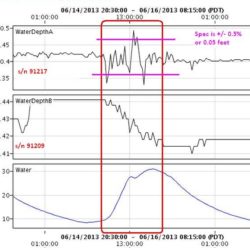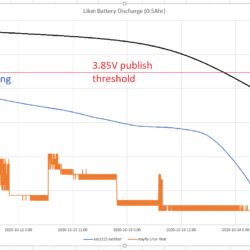Forum Replies Created
-
AuthorPosts
-
Well after running for some time with the WiFi S6B, and still having problems after it has been running for a couple of hours,
I’ve switched to one my target field internet comms of Digi XBee3 LTE-M over Verizon.Very interesting the Digikey RevXsystems https://dataplans.digikey.com (thanks to @mbarney for the suggestion) has a new low cost 50M/month CAT-M1 plan.
Wow this is excellent!. Based on some recent past experience with a marginal/failing system this is going to be worthwhile.Since this was a new Xbee3 LTE, I have upgraded the Xbee3 to the latest software using the Digi “TH Development” board. Then with on the LTE adapter on the Mayfly, I plugged in the battery. At its core the sw is @srgdamiano hard sweat with DigiXBeeCellularTransparent.cpp, though I have modified it to show the connecting process to the cell network.
Since connecting for the first time over LTE and Verizon is such an occasional event, I thought I would paste in the trace.
It connected first time… (whew!)
Attempting to connect to the internet and synchronize RTC with NIST
This may take up to two minutes!
Lte internet comms with Digi XBee3 Cellular LTE-M IMEI OK HwVer 4B48 FwVer 11417
Loop=Sec] rx db : Status ‘ Operator ‘ #Polled Cell Status every 1sec
0=7.89] 0:0x22 ‘OK’
1=8.91] 0:0x22 ‘OK’
2=9.93] 0:0xff ‘OK’
WATCHDOG ISR barksUntilReset 149 <–WatchDogAVR
3=10.95] 0:0xff ‘OK’
4=11.97] 0:0xff ‘OK’
5=12.99] 0:0xff ‘OK’
6=14.01] 0:0xff ‘OK’
7=15.04] 0:0x22 ‘OK’
8=16.06] 0:0x22 ‘OK’
9=17.08] 0:0x22 ‘OK’
10=18.10] 0:0x22 ‘OK’
Try +CREG ‘
11=19.13] 0:0xe ’22’
WATCHDOG ISR barksUntilReset 148 <–WatchDogAVR
12=20.15] 0:0x0 ’22’ Cnt=1
13=21.17] 0:0x0 ’22’ Cnt=2
14=22.19] 0:0x0 ’22’ Cnt=3
Digi Xbee3 setup Sucess. Registration ‘ 0 ‘
mdmIP[ 1 / 16 ] ‘ 0.0.0.0 ‘= 7
mdmIP[ 2 / 16 ] ‘ 0.0.0.0 ‘= 7
WATCHDOG ISR barksUntilReset 147 <–WatchDogAVR
mdmIP[ 3 / 16 ] ‘ 0.0.0.0 ‘= 7
mdmIP[ 4 / 16 ] ‘ 0.0.0.0 ‘= 7
mdmIP[ 5 / 16 ] ‘ 100.104.156.99 ‘= 14
XbeeWLTE IP# [ 100.104.156.99 ]
0 ] Connect time.nist.gov
WATCHDOG ISR barksUntilReset 146 <–WatchDogAVR
WATCHDOG ISR barksUntilReset 145 <–WatchDogAVR
1 ] Connect time.nist.gov
WATCHDOG ISR barksUntilReset 144 <–WatchDogAVR
NIST responded after 2562 ms
Internal Clock within 5 seconds of NIST.
Putting modem to sleepSome status – the periodic Mayfly RESETs turned out, I think, to be happening when polling the Insitu LT500 gauge over SDI12. https://github.com/EnviroDIY/ModularSensors/issues/344
The new code breaks the polling of the Insitu LT500, I’m doing debug under various scenarios to try and under stand it.
https://github.com/EnviroDIY/ModularSensors/issues/346I’m seeing instability on the WiFi S6B hybrid that I didn’t see on the 0.25.0 release. It is repeatable, but doesn’t make a lot of sense to me at this point – so maybe its driver error. https://github.com/EnviroDIY/ModularSensors/issues/347
My next step is to try and do a poweroff of the WiFi S6B instead of Sleep using the LTE Bee Adapter.The latest release of ModularSensors 0.27.0 has a new simple electrical conductivity sensors ~ AnalogElecConductivity.h/.cpp
Thanks to Sara for accepting it as a MS sensor and formatting it to the latest documentation style. See the amazing Doxygen generated https://envirodiy.github.io/ModularSensors/group__sensor__analog__cond.html
Sara has also added to example/menu_a_la_carte.ino
See Variable* analogEc_condIts a “simple sensor” ~ meaning low cost low resolution using the Mayfly mega1284’s ADC 10bit.I should emphasize as released, all calibration and determination of fitness for purpose. safety analysis for specific usage, is on the user.Its based on a standalone Mayfly sensor I built for monitoring “Stream Disconnect”.The purpose is to measure when a stream’s level hydrograph is dropping, and to be able to determine approximately when the stream’s flows “disconnect”. In recent studies for streams in the dry Mediterranean Western USA this is a significant event for the streams biology.I hope to do a separate discussion on the full unit I built, including a separate interface board but that will have to be for later. The wip is at https://github.com/neilh10/ModularSensors/wiki/Stream-Disconnect-EC-MonitorHi Matt – well been watching the output of the LC709203F with some other testing. It does work for the accurate battery voltage measurement.
However the LC709203F “%” capacity could be challenging to use. There is a lot of technical discussion about battery fuel gauges and what works and doesn’t. Another device that I got was the Seeed LTC2941 which only measures coulombs/mAHrs .
https://www.seeedstudio.com/Grove-Coulomb-Counter-3-3V-to-5V-LTC2941.html
I’m figuring out it needs to be accurate battery voltage ~ for basic battery “gauge” status, and also measure mAhrs to be able to characterize activity (or field monitor) while awake. My test system with Xbee S6, periodically goes into some sort of lock up and consumes current, and the only way to recover is to unplug the battery. For the Xbee LTE carrier board it can be turned off if this happened.
The LTC2942 does coulombs and battery voltage – except no cheap board with it that I’ve found.
An fun link about “orchestrating power” from some work being done at CMU on dealing with power – https://youtu.be/eAhVdSCdv08
Wishing you a good safe thanksgiving – great time of year for giving thanks 🙂
My experience is that its not capable of that.
I have been doing a lot of testing in pushing up readings to test Mayfly reliable data delivery algorithms I have evolved. I have in some cases had 6000 points to push (ie 60days of unreported readings at 15minutes per reading), and MMW has been very slow, often after a small number (~10) of POSTs it will timeout – no response after 5seconds.
An observation I would make is that fast data – 1second pushes – is a different type of data collection .
My guess from looking at the MMW POST is that traceability and security of the readings has been prioritized over speed. ThinkSpeak and other servers discuss fast posts and have less data on each POST https://thingspeak.com/prices/thingspeak_standard
So for anybody needing fast post, ThingSpeak supported by ModularSensors would be the way to start.
A MMW post looks like this – which has a lot of text overheads – from a fast post architecture, the core data is in bold.
POST /api/data-stream/ HTTP/1.1
Host: data.envirodiy.org
TOKEN: 7ff7ae1b-9274-4376-afa8-8bf5a64f9b4f
Content-Length: 370
Content-Type: application/json{“sampling_feature”:”42c01940-952e-4a68-9d34-f8203cd0dd18“,”timestamp”:”2020-11-13T15:00:00-08:00″,”737aacd2-0259-4be1-9190-07308b9fdae4″:1,”479f16f0-1e46-4d3e-8a80-286b7997608e”:4.079,”2d2b543e-a721-4393-8a9f-f3f928d04ac3″:-9999.00,”d81f73a0-5c02-4b19-8280-13514bd6b4bf”:-9999.0000,”ec937dc1-a40e-41e3-946f-443f3af680ba”:-25}
Continuing some ideas on https://www.envirodiy.org/topic/battery-capacity-fuel-gauge
2020-11-15 at 10:13 PM in reply to: DFRobot Gravity KIT0139 Depth Sensor – Routine Interference? #14821Hi James, very interesting. I wonder which Analog port on the mayfly you are using, ADS1115.?
One test I do, to verify the sensors response, is put the sensor in a simulated stationery stream, (jug of water) with a solar aspect, stable power supply voltage, and measure water temperature and water temperature together and see what it reports.
Water temperature sensors https://www.seeedstudio.com/One-Wire-Temperature-Sensor-p-1235.html
These sensors typically use a varying resistance with pressure change (water depth) and are influenced by temperature. I’ve seen some sensors that have nonlinear changes with temperature – depends on internal algorithms. The KIT0130 states it has temperature compensation, but not what the range is – but who can complain at the price.
Eyeballing your graph – its +-/10mm – but whats the temperature change. 🙂
One set of measurements I did on two individual sensors that where in the same family, with a stated temperature specification showed the non-linearity in some of the sensors. They where returned.
Attachments:
Hi Brian, You may want to describe the type of tipping bucket and the electrical interface for counting . Some types of relay contacts can oxidize and require a minimum wetting current at some point. Do you have a link for the ProTrinket.? regards
I’m sharing some integration test results. I’ve been using a Vbat=4.0V threshold – that is under Vbat=4.0V it does sensor readings only, and stores the readings for later reliable data delivery.
When the battery voltage is over Vbat=4.0V it POSTs the readings to MMW.

A feature of using 4.0V is that probably works for the Mayfly Vbat measurement, and really extends the effective life of the battery when there is no solar. A wrinkle is that a lot of readings can be stored, which could exhaust the available power in the battery if all transmitted in one shot. So when a connection is made after X(default=10) retransmission of POSTS from the FIFO file, it checks the battery again to see if it is still over 4.0V.
These are all on my “rel1_dvlp1m” branch – https://github.com/neilh10/ModularSensors/tree/rel1_dvlp1m – and I’ll plan to describe it and make a release in the near future.
I’ve had a simple system soak testing. Its not meant to be a deployable system, but I’m using it for testing out powering related algorithms.
It has an Xbee WiFi, LiIon 500mA, measuring MayflyVbat and ADS1115 extVbat. When the extVbat voltage is >=3.85V it will
Logger dataLogger.logDataAndPublish();
and when below <3.85V only
Logger dataLogger.logData();
I’ve used the 3.85 threshold as I found the Mayfly was resetting when the WiFi turned on and LiIon battery was around 3.7V.
For the “Solar Panel” I’ve got it connected to a power supply and simulating low sunlight conditions with a charge typically round 25mA.
The graph of this running since Oct 10th is
Attachments:
-
AuthorPosts

 Welcome to EnviroDIY, a community for do-it-yourself environmental science and monitoring. EnviroDIY is part of
Welcome to EnviroDIY, a community for do-it-yourself environmental science and monitoring. EnviroDIY is part of 
